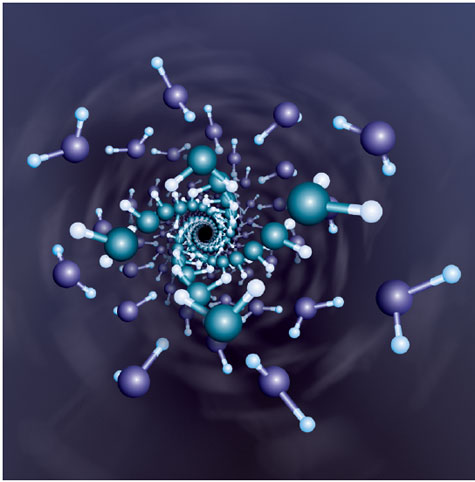Ice Entwined
By Fenella Saunders
Frozen water takes on intricate multi-helixed shapes when confined in tiny spaces at high pressures
Frozen water takes on intricate multi-helixed shapes when confined in tiny spaces at high pressures

DOI: 10.1511/2007.64.121
For a simple collection of hydrogen and oxygen atoms, water has an astounding repertoire of contortionist tricks when frozen. It works particularly well under pressure. In bulk quantities, there are 15 known forms of ice, only a few of which occur at normal atmospheric pressure. "There are so many unique things about water," says Xiao Cheng Zeng, a chemist at the University of Nebraska-Lincoln. Zeng decided to check out ice's act when it is forced into microscopic containment—in this case, into carbon nanotubes less than 2 nanometers in diameter. He and his colleagues Jaeil Bai and Jun Wang have found that ice has a whole new repertoire when it's pushed into a tight spot.

Image courtesy of the Office of Research, University of Nebraska-Lincoln.
Zeng and his colleagues use supercomputers to model the molecular dynamics of water molecules confined within carbon nanotubes. A few years ago, the group created models for four new types of ice in these close quarters at relatively low pressures—only a few tens of times atmospheric pressure. Several groups have now experimentally proven that these modeled forms of ice actually exist when water is frozen in carbon nanotubes under such conditions. But since bulk ice has so many more forms under high pressure, Zeng and his colleagues wanted to see how ice would react if they put the squeeze on the nanotubes as well.
In the December 26, 2006, edition of the Proceedings of the National Academy of Sciences of the U.S.A., Zeng's group reported that they had simulated subjecting the ice in the carbon nanotubes to pressures of 10 to 40,000 atmospheres. Each experiment's reaction time was no more than a few tens of nanoseconds. The investigators expected that the ice would simply roll up into a tubular structure—and for four of the six resulting phases, this was the case. But for two sets of parameters, the ice spontaneously transformed itself into nested helixes with multiple strands.
In a 1.35-nanometer tube at a temperature of minus 9 degrees Fahrenheit and 40,000 atmospheres of pressure, the ice became a double helix that somewhat resembles DNA in structure, except the outer sheath has eight strands and the inner layer has four. In another simulation of a 1.9-nanometer tube at the same temperature, when the pressure was suddenly raised from 10 atmospheres to 8,000, the water abruptly froze into a helical formation with triple-layered walls. In this case, the outermost wall had 18 strands and the two ice sheaths nested inside of it each had six. "They are intertwined together like a braid of chains," explains Zeng. "At the highest pressures, we were surprised to find that the helix is the most stable formation of ice."
High pressures force a large number of water molecules to pack themselves into the carbon nanotube. Zeng suspects that the helix may be an efficient way for the molecules to arrange themselves to be as compact as possible at extreme densities. Hydrogen bonding is also involved. Hydrogens from the inner chain match with those in the outer wall, and each water molecule prefers to be bonded to four others in a tetrahedral structure.
It took several years for experiments to confirm Zeng's previous models of low-density ice in carbon nanotubes, and it's much more challenging to create such high pressures in the lab than it is on a computer, but Zeng is hopeful that the new high-density ice structures will eventually be found in the laboratory. If so, that will bring the total number of ice's known contortions to about 25 different structures.
Because the way that these ice structures assemble themselves somewhat resembles the assembly of certain proteins, there is some hope that the new study could be applied to understanding basic biological processes, such as the protein misfoldings associated with mad-cow disease and other illnesses. Also, because the water molecules spontaneously assemble themselves into such a complex arrangement, it might also be possible that Zeng's results could aid in the fabrication of intricate materials at the nanoscale. "This helix of ice is a cooperative arrangement of tens of thousands of molecules together. They have to act in a cohesive way to form this kind of unique structure. It's not like a polymer where they are already connected by strong bonds," Zeng says.
But Zeng himself is most interested in knowing more about water for its own sake: "Water and life go hand in hand, so that's the most important reason why we study it."
Click "American Scientist" to access home page
American Scientist Comments and Discussion
To discuss our articles or comment on them, please share them and tag American Scientist on social media platforms. Here are links to our profiles on Twitter, Facebook, and LinkedIn.
If we re-share your post, we will moderate comments/discussion following our comments policy.